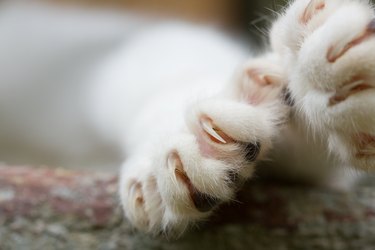Cuteness may earn compensation through affiliate links in this article.

Cats are natural predators equipped with sharp claws to help them climb and leap onto surfaces. Unfortunately, when we bring cats indoors, those same instincts to leap and climb can lead to destruction. If your cat is scratching at the door in the morning, he may just be exercising his natural behaviors but shredding your door frame and redecorating your door in the process. Luckily, there are a number of ways you can discourage and end this behavior.
Video of the Day
Video of the Day
Understand why your cat is scratching
Understanding the reasons behind this behavior can help you to stop your cat from scratching the door. Your cat may be scratching your door to:
- Clean and maintain her claws
- Mark her territory, which she may feel she needs to do if there's another cat in the house or if she can smell cats outdoors
- Exercise and stretch her body and relieve pent-up energy
- Entertain herself and break up boredom
If your cat is feeling particularly stressed, she's more likely to scratch vertically by targeting a door frame. This behavior can indicate that your cat is nervous or unhappy, so it's particularly important to try to understand what's prompting her scratching so that you can help her feel happier and safer.
Use cat scratch door protectors
It may take some experimentation to find the right solution to stopping your cat's scratching, but in the meantime, you need to protect your door. You can purchase clear cat scratch door protectors to stop your cat from damaging the door. The slick surface of the Petfect Pet Scratch Protector, for example, takes away the sensation of being able to sharpen her claws, eliminating the behavior in that area.
Alternatively, place double-sided sticky tape on the door to discourage your cat from scratching. Medical grade adhesive sheets designed particularly for deterring cat scratching, such as Sticky Paws XL, are transparent and have a texture cats hate to touch.
Place a vinyl carpet runner upside down in front of the door since your cat won't enjoy stepping on the little plastic knobs that usually secure it into the carpet. Products like KittySmart Carpet Scratch Stopper are pre-sized to fit in standard doorways. This solution also stops cats from scratching the carpet at the threshold, a common kitty pasttime.
Cap your cat's claws with Purrdy Paws Soft Cat Nail Caps, The soft vinyl caps adhere to your cat's claws and stay on until your cat sheds its claw. Choose from neutral shades or a variety of sparkly and glossy colors also bring out your pet's personality. The product was designed by veterinarians to be a humane solution to scratching issues.
Provide alternative options
If your cat is scratching to mark her territory, relieve energy, or maintain her claws, she'll need alternative places to relieve this instinct to scratch. Offer her a variety of scratching posts, cardboard scratch pads, and cat furniture.
Set up your cat's new scratching post in front of or near the door that she was previously scratching to encourage her to transfer the behavior to the new object. Rubbing some catnip on the post can help to pique her interest too. Hang a flat scratching post from the doorknob to provide an acceptable target for kitty claws. Omega Paw Door Hanging Cat Scratchy Pad is treated with catnip to entice your cat to use it instead of the doorpost.
It's also important to provide your cat with a way to relieve her excess energy. You can do this by offering your cat new toys and playing with her. Installing a cat-climbing jungle gym or other network of cat furniture can allow your cat to climb vertically and leap from platform to platform, keeping her entertained and using up the energy she would have spent scratching your door.
For floor play, the Snugglycat Ripple Rug Cat Activity Play Mat can be easily reconfigured using its velcro attachments to provide new and exciting caves and tunnels for your cat to claw its way through. The non-slip bottom carpet provides a soft, thermal base for a catnap in hiding when your feline gets tuckered out.
Avoid declawing your cat
It may be tempting to take your cat to the vet to be declawed, but this procedure is highly painful and is not regarded as a solution to behavioral issues such as clawing at a door. When a cat is declawed, the last digital bone on each toe is amputated. Cats also face risks from the anesthesia, the possibility of excessive bleeding, and potential infection after the operation.
Instead of declawing your cat, explore the many ways you can redirect his behavior and better understand what's causing him to claw at your door in the first place. By exploring different solutions, you'll probably make your cat happier and healthier as a result.